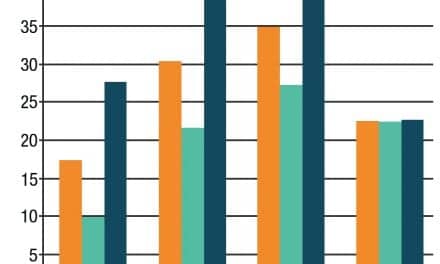SeboTek Hearing Systems’ PAC system increases user comfort by separating the sound processor and speaker.

Since its founding in 2001, SeboTek Hearing Systems, LLC, has offered patients a new item on the menu of hearing instruments, its post auricular canal (PAC) hearing instrument. The system separates the sound processor and speaker, which sits deep inside the ear canal. The arrangement allows for a more discreet and comfortable fit. Started by brothers Jim and Mike Feeley, SeboTek employs approximately 60 people at its Tulsa, Okla, headquarters. Jim, 42, who is president of the company, and Mike, 38, vice president, have been in the hearing industry for 20 years, and also operate a company specializing in custom-fit hearing instruments. Hearing Products Report (HPR) recently had the opportunity to interview the Feeley brothers.
HPR: What was the genesis of the PAC Hearing System?
Mike Feeley: A lot of the inspiration came from our mission trips. And it was on a mission trip that we were fitting some BTE instruments down in the southern jungles of Mexico in a very poor area, and we were very frustrated by our inability to adequately help people. From a fitting standpoint not being able to have a custom earmold, we were frustrated dealing with feedback and really not able to give an appropriate fitting. And we knew as soon as we left, if something went wrong with these instruments, there’s no way to service them. So that was part of our goal, to develop an instrument that can fit severe hearing losses conveniently and effectively without having to build a custom earmold, and also be able to provide simple service. What we were in pursuit of was to develop a device that would have better reparability. It had to be something simple so that a missionary could do a speaker replacement on-site or at a dispenser’s office by just snapping it in and out.
HPR: What was the research and development process like?
Jim Feeley: The development process actually took several years to evolve, both here at SeboTek as well as elsewhere in the industry. We are fortunate to have both the manufacturing and dispensing functions within our facility, giving us the ability to build prototypes and obtain immediate patient responses. Just as important, the dispensing office has given us the ability to gauge long durability of the product after being worn in the field for months and even years. In all, PAC instruments in various designs have been fit on thousands of patients to bring us to our presently offered model.
HPR: What are the advantages of the PAC technology for dispensers?
Jim: One major benefit is that this is an instrument that you can demonstrate in the office. Many hearing care professionals find it challenging to effectively communicate the benefits of the latest digital signal processing technologies because the patient cannot feel it, see it, or hear it until their product is delivered. With a PAC hearing system, the benefits can be immediately realized. Once the instruments are in the patient’s ears, they can see what they look like wearing PAC, they can feel how comfortable PAC instruments are to wear, they can listen to the improvement in their hearing and experience the benefits of the directional microphones. Best of all, patients can walk out your office door wearing the instruments and begin enjoying the benefits of amplification that very day. PAC will help hearing professionals make the dispensing process more efficient. There are no impressions to make, no shell modifications, remakes, or delays experienced while waiting for custom instruments. Additionally, most service repairs can be handled the same day. So, as you can see, there are quite a few, unique advantages that PAC will offer to any dispensing practice.
Mike: Overall, it’s a much easier system to fit and it’s going to save busy hearing centers a lot of time. Being able to combine the hearing evaluation and the fitting all in one visit will increase productivity while building patient satisfaction.
HPR: What acoustic advantage does PAC have?
Mike: There are several significant acoustic advantages of the PAC design. One of the greatest is the reduction in feedback sensitivity, which results from the separation of the speaker and the directional microphones. Another leading advantage is that the deep canal speaker placement increases the effective sound pressure in the ear canal, resulting in improved, high frequency performance. We recognize that there are many, excellent-performing digital signal processors available, of which PAC is one. However, PAC substantially changes how that sound is delivered by combining its signal processing with its patented, acoustic design. The result is exceptional sound quality combined with cosmetic and comfort benefits.
HPR: What are the advantages for the patient?
Jim: One of the more common things patients seek out is the appearance of the hearing aid. I think one of the [advantages] PAC offers is that it is one of the most discreet products available. This feature is especially important with more severe losses where patients previously have had fewer options. Only PAC allows hearing aid wearers to obtain their cosmetic preferences and, at the same time, gives them the features that are regarded providing the best listening benefit—multiple memories, directional microphones, and DSP.
Mike: And that’s really huge. Most hearing professionals can probably come up with several patients who will only want to wear a CIC but really need to be wearing a full shell or a BTE because of the severity of their hearing loss. The result is that this type of patient, one, would be less than satisfied due to feedback or inadequate amplification. Or second, they would be wearing an instrument that is not cosmetically satisfactory to them. Or third, either the patient will elect not to buy hearing instruments, or if they do, their instruments will be left in their dresser drawer. And PAC is a perfect product to remedy all of these situations.
HPR: What is the fitting process like?
Jim: The process is actually quite simple and involves just three steps. Step one is the selection of the appropriate Speaker Link. Second is selecting the correct Ultra Soft Tip size. And third is programming the Sound Processor. Typically, the first two steps can be done in less time than is needed to take an impression. Programming the Sound Processor using the PAC AutoFit feature is also a very simple process. The PAC AutoFit system is the result of evaluating patient experiences in our facility. Our ability to personally interact with thousands of hearing aid patients made it possible for us to create a reliable fitting strategy for most patients on their initial PAC fitting.
HPR: Do people find it more comfortable than wearing a traditional hearing device?
Mike: [Patients find it] far more comfortable—and that’s another beauty of this product. The way the unit is designed, the speaker is suspended in the ear canal between the first and second bend. The Ultra Soft silicone tip seals in the bony portion of the canal. When properly inserted, the Ultra Soft Tip greatly reduces or eliminates the occlusion effect; it will not work its way out of the canal even with excessive jaw movement and is extremely comfortable. For patients who have previously worn hearing aids, the difference can be dramatic.
HPR: What kind of support do you offer dispensers?
Mike: To support new customers, we utilize a team of support people who have had extensive experience here in our dispensing facility fitting PAC instruments. Their enthusiasm and experience with the instrument have assisted new PAC dispensers to become quickly proficient fitting their PAC patients. This same team has helped create our training materials, which we offer both in brochure form as well as our Web site. Because there are no impressions needed to order PAC instruments, we believe that much of the ordering of PAC instruments and supplies, as well as order tracking and service, can be accomplished via the Internet, at a time when it is most convenient for the hearing professional. Our new Web site reflects our goal of being able to provide online service and support, including providing product information, product training, software downloads, fitting support, as well as placement of new orders and tracking existing orders. The Web page is currently set up only to serve the hearing professional. In addition, our retail practice enables us to test various market ideas that we intend to share with our professional base including direct mail, ad slicks, television commercials, and in-store displays. Again, our retail background and access to the end user make SeboTek an attractive partner for other hearing health practitioners.
HPR: What does the future hold for SeboTek and the PAC Hearing System?
Jim: We believe that the PAC system belongs in every hearing professional’s office. If the market is to grow by reaching consumers who have chosen not to purchase traditional instruments, PAC is an option that will almost certainly convert some reluctant nonusers. And don’t forget, PAC is a great demonstration asset. Potentially, it can help lower returns for credit, reduce service issues, and build customer satisfaction. So in the short term, our focus will be dedicated to building awareness and acceptance for the PAC by both hearing professionals and the patients they serve. We are already planning future models. We expect the first of these new models to be available well before the end of this year.
Rosie M. Banks is a contributing writer for Hearing Products Report.




